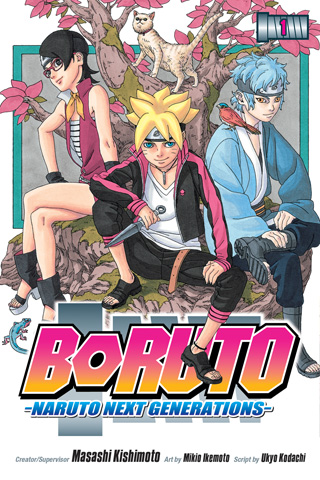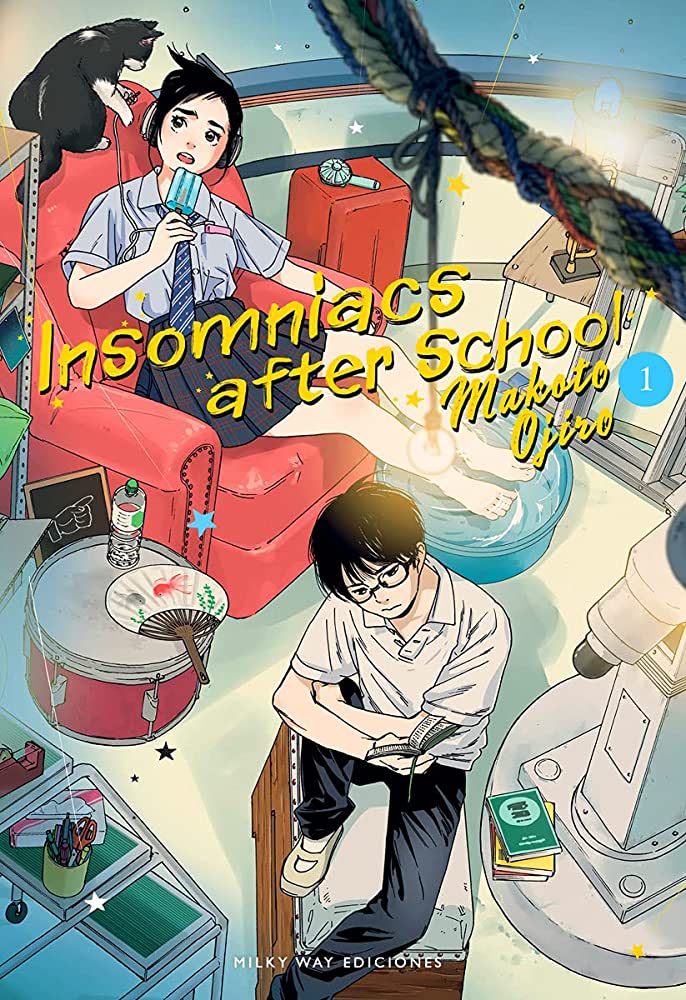Since its 1999 debut, Masashi Kishimoto’s Naruto has sold more than 220 million volumes in 35 countries and spawned a cottage industry of anime adaptations, costumes, trading cards, video games, figurines, and stage plays. VIZ published the final English-language volume in 2015, but the series’ popularity endures; walk through any American comic-con, and you’ll find small gangs of Narutos and Sasukes roaming the floor alongside Superman, Batman, and Sailor Moon.
In the post-Naruto era, VIZ has supplied hardcore fans with a steady stream of spin-off products, from light novels to coffee-table books. The company’s latest offering is Boruto: Naruto Next Generations, a manga written and illustrated by Ukyo Kodachi and Mikio Ikemoto under Kishimoto’s supervision. The story focuses on three new characters: Boruto (Naruto and Hinata’s son), Sarada (Sasuke and Sakura’s daughter), and Mitsuki (a young ninja of uncertain origins), all of whom enter the Chunin Exam, a tournament for aspiring ninjas. Running in tandem with the trio’s quest for victory are two subplots, the first centering on the return of the Otsutsuki clan and the second on a cloning scheme orchestrated by one of Naruto’s old nemeses.
While it’s obvious that Next Generations is aimed at ride-or-die fans, Kodachi deserves a medal for his efforts to make the story accessible to the uninitiated as well. Some of these expository passages are a little clumsy, but the pacing is brisk enough to smooth over the less graceful exchanges. The artwork, too, is competently executed; Ikemoto’s character designs create a strong visual continuity with the original series, making it easier for readers to grasp who’s related to whom.
On the minus side, Next Generations straddles the fence between remake and sequel, never fully settling on one approach. In an effort to show us that Boruto is just like his dad, for example, Kodachi portrays Boruto as impatient, brash, and… well, that’s about it. Reduced to a third-generation photocopy of his father, Boruto lacks a real identity or purpose of his own, despite Kodachi’s efforts to manufacture father-son drama. The decision to enter Boruto in the Chunin Exam is further evidence of the creators’ unwillingness to take risks. Boruto’s experiences may be a little different than his dad’s, but the tasks and outcomes tack so closely to the original that they, too, register as bad facsimiles, rather than an organic continuation of the Uzumakis’ saga.
The other problem with Next Generations is that the bad guys are cooler than the good guys. To be sure, this is a frequent issue in shonen manga; villains often get the snappiest lines and deadliest weapons while heroes are reduced to blustering about courage, teamwork, and loyalty. This problem nearly sinks the first volume of Next Generations, however, as Orochimaru — one of the most memorable villains in the original series — oozes sinister purpose in his cameo appearance, making a more immediate impression than any of Konoha’s do-gooder teens; he’s compulsively “watchable,” whether he’s browbeating one of his minions or playing at fatherhood.
Whether Orochimaru will be Next Generations’ principal baddie is unclear, as volume one introduces yet another flamboyant villain: Kawaki. If I had to hazard a guess about who Kawaki is, I’d say he was a refugee from JoJo’s Bizarre Adventure, as his two-tone hairdo and dramatic tattoos are just a little too fabulous for the Naruto universe. I’m not sure if he’s a portent of what’s to come in volume two or a hint of what Kodachi and Ikemoto might have created if they’d been given more latitude by Kishimoto; either way, finding out who Kawaki is the only reason I’d continue reading Next Generations.
The bottom line: If you’re a self-professed Naruto fan, Next Generations will offer just enough fresh material to affirm your love of all things Kishimoto; if not, you may find Next Generations a tedious slog.
Review copy provided by VIZ Media.
BORUTO: NARUTO NEXT GENERATIONS, VOL. 1 • CREATED BY MASASHI KISHIMOTO, ILLUSTRATED BY MIKIO IKEMOTO, AND WRITTEN BY UKYO KODACHI • VIZ MEDIA • RATED T (FOR TEENS)



